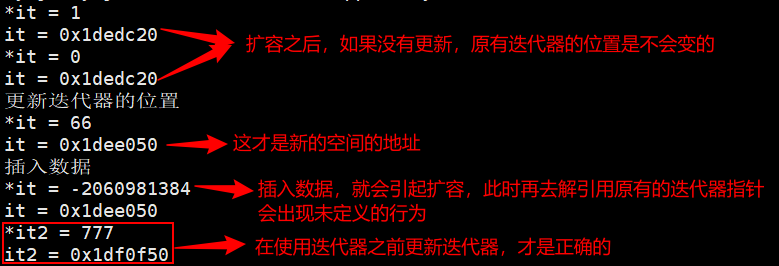扩容及迭代器失效问题
vector扩容问题
vector在尾部插入(push_back)时的扩容
void test3()
{
vector<int> num = {1,2,3,4,5};
cout << "num.size() = " << num.size() << endl;
cout << "num.capacity() = " << num.capacity() << endl;
num.push_back(6);
cout << "num.size() = " << num.size() << endl;
cout << "num.capacity() = " << num.capacity() << endl;
num.push_back(7);
num.push_back(8);
num.push_back(9);
num.push_back(0);
num.push_back(11);
cout << "num.size() = " << num.size() << endl;
cout << "num.capacity() = " << num.capacity() << endl;
}
运行结果:

可以看到每次扩容都是原来容量的2倍,是固定的。
vector在任意位置插入(insert)时的扩容
void test4()
{
vector<int> num = {1,2,3,4,5};
num.push_back(6);
vector<int>::iterator it = num.begin();
it++;
it++;
cout << "num.size() = " << num.size() << endl;
cout << "num.capacity() = " << num.capacity() << endl;
cout << "设size = m = 6,capacity = n = 10,待插入元素个数为 t." << endl;
cout << "1.当 t <= n -m 时,不会扩容" << endl;
cout << "2.当 n - m < t < m 时,此时会按照 2 * m 进行扩容:" << endl;
num.insert(it,5,66);
cout << " m = num.size() = " << num.size() << endl;
cout << " n = num.capacity() = " << num.capacity() << endl;
cout << "3.当 n - m < t 且 m <= t 时,此时会按照 m + t 进行扩容:" << endl;
// 注意,此时需要更新迭代器的位置才能插入
it = num.begin();
it++;
it++;
num.insert(it,11,777);
cout << " m = num.size() = " << num.size() << endl;
cout << " n = num.capacity() = " << num.capacity() << endl;
}
运行结果:

小结
对于vector的扩容,由于push_back()和insert()引起的扩容,其底层扩容机制是不一样的。
- 在尾部插入时,每次只能插入一个元素,此时按照2 * capacity进行扩容即可,是肯定不会出现问题的。
- 但是通过insert插入时,每次插入元素的个数不确定,所以不能单纯按照2 * capacity进行扩容。
- 当 待插入元素t <= capacity - size 时,不需要扩容
- 当 capacity - size < 待插入元素t ,且待插入元素t < m 时,此时按照 2 * size进行扩容
- 当 capacity - size < 待插入元素t ,且m <= 待插入元素t 时,此时按照 size + t 进行扩容
迭代器失效问题
我们知道,vector在进行扩容时,会开辟一块新的空间,将原有空间中的内容复制过来,随后将原有的空间回收。而此时迭代器仍然指向原来的那片内存,故此时迭代器就会出现失效的问题。
void test2()
{
vector<int> num = {1,2,3,4,5};
vector<int>::iterator it = num.begin();
cout << "*it = " << *it << endl;
printf("it = %p\n",&(*it));
num.insert(it,3000,66);
cout << "*it = " << *it << endl; // 未定义的行为(此时it所指向的区域已经被回收了)
printf("it = %p\n",&(*it));
// num.insert(it,3000); // error,如果仍然以原有的迭代器为基准进行插入,就会出现错误
// 解决方法:更新迭代器
cout << "更新迭代器的位置 " << endl;
it = num.begin();
cout << "*it = " << *it << endl;
printf("it = %p\n",&(*it));
cout << "插入数据" << endl;
num.insert(it,777); // ok
cout << "*it = " << *it << endl; // 未定义的行为
printf("it = %p\n",&(*it));
vector<int>::iterator it2 = num.begin();
cout << "*it2 = " << *it2 << endl; // ok
printf("it2 = %p\n",&(*it2));
}
运行结果:

小结
- 对于vector,其迭代器是真实的指针,所以可以在上述例子中用printf打印出来,但是对于其他容器的迭代器,很有可能根本不是一个真实的指针,是不可以这样操作的,这一点需要注意。
- 由此可见,vector在插入元素时,有时会引起其底层的扩容,这时会导致原有的迭代器失效。为解决此问题,我们在插入元素之后,操作迭代器之前,最好更新一下迭代器的位置,让迭代器指向新的空间的位置,避免出错。
- 特别的,对于deque而言,去进行insert操作的时候,也有可能迭代器失效,所以最好还是可以每次使用迭代器的时候,像vector一样,将迭代器的位置进行更新,指向新的空间的位置。

